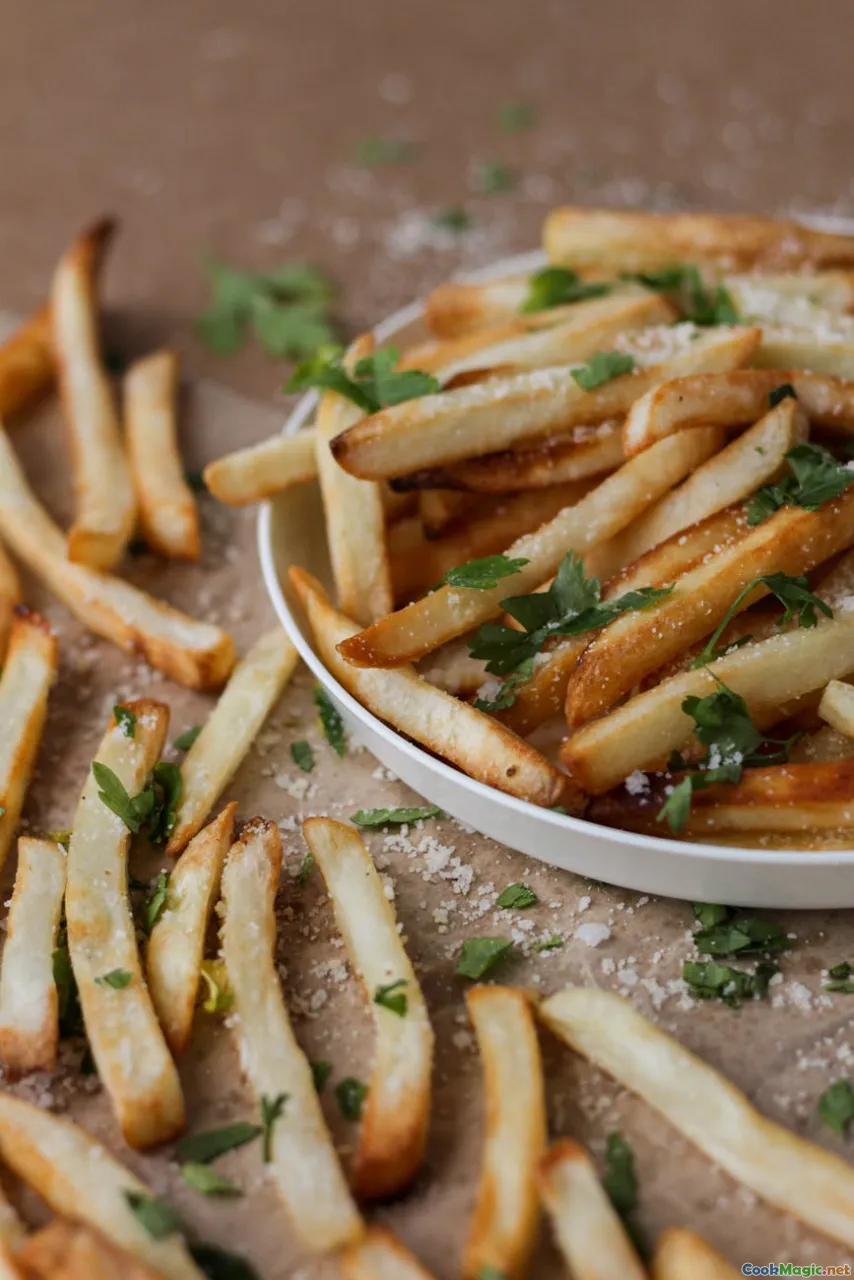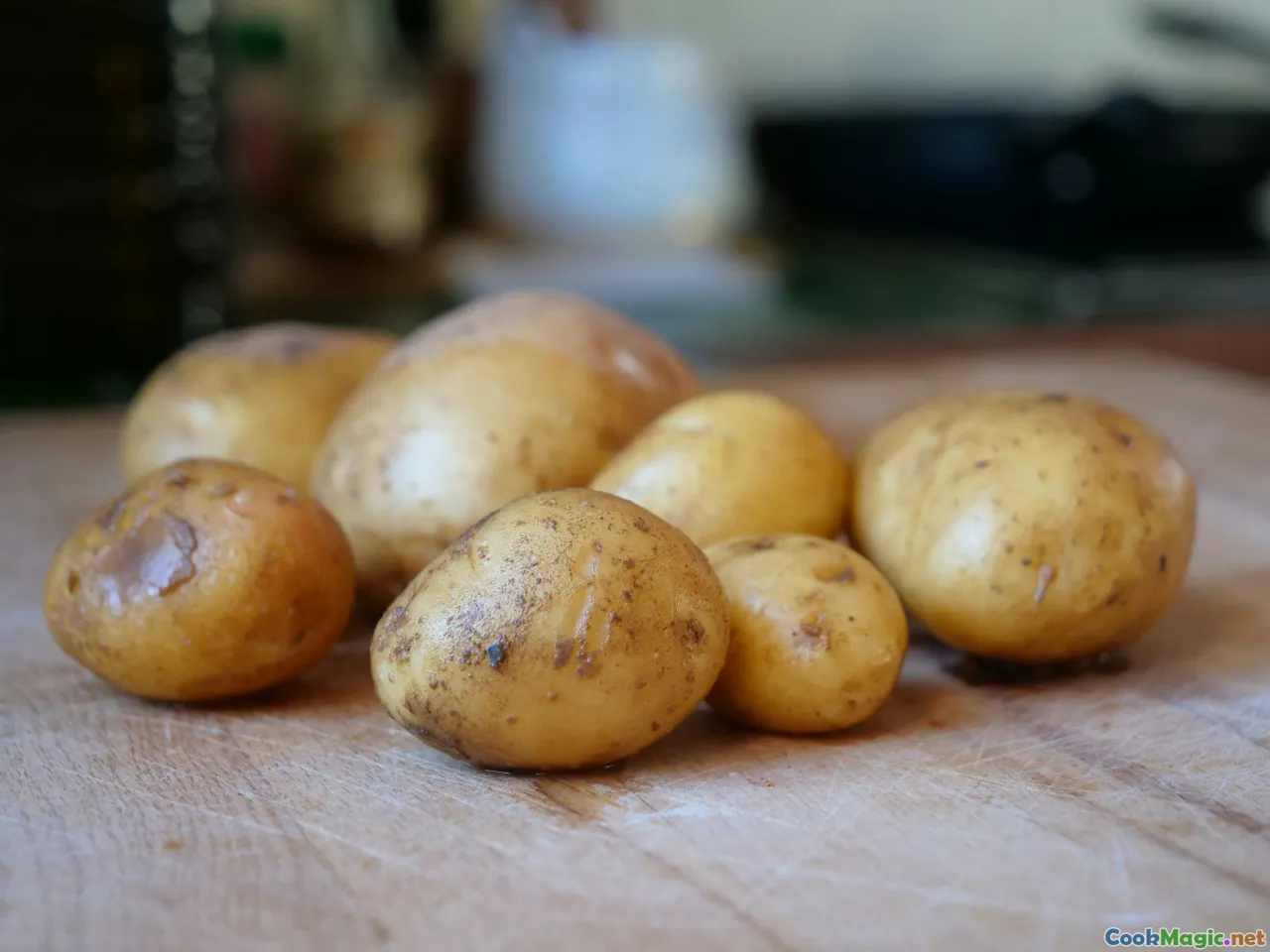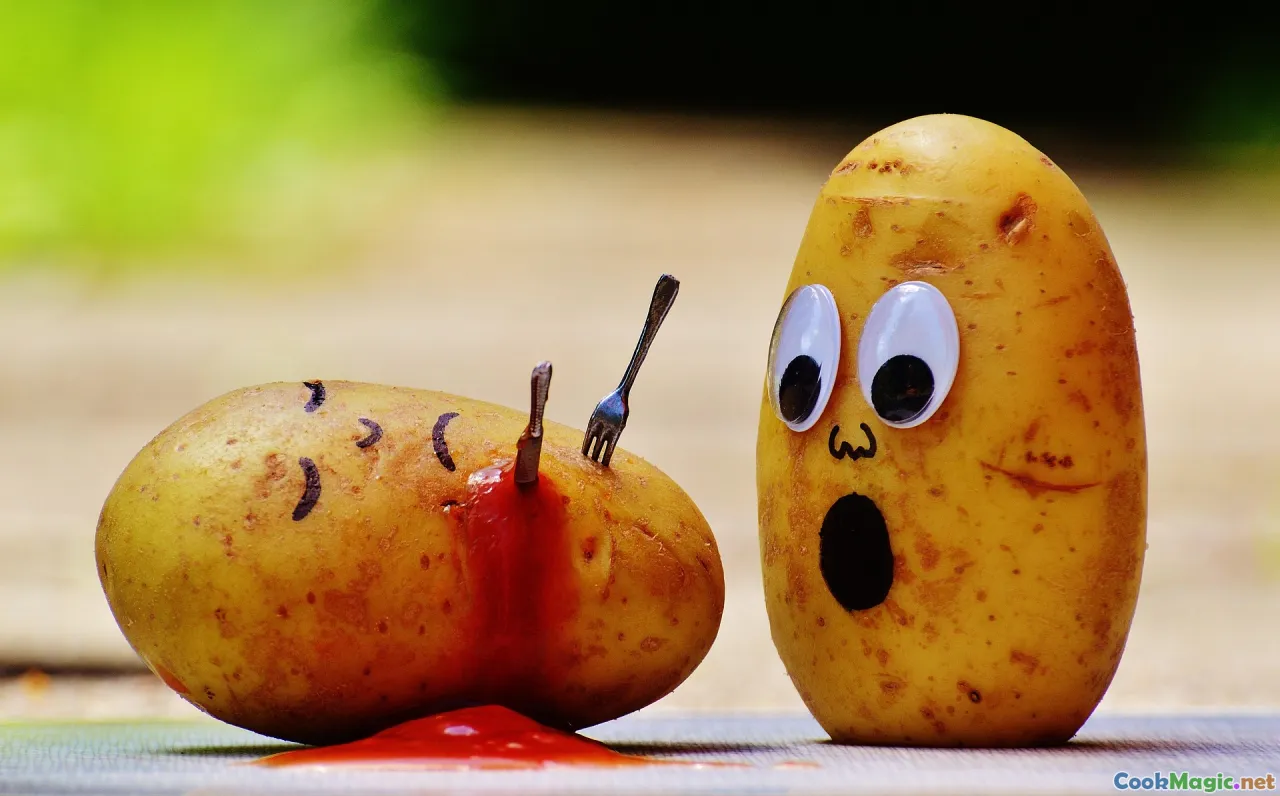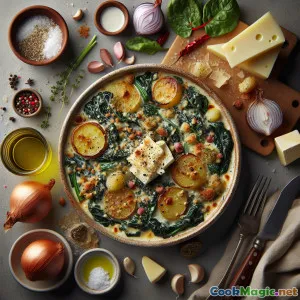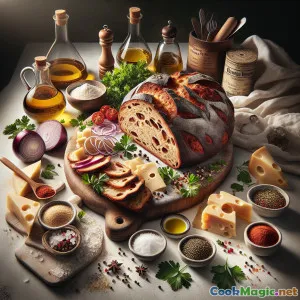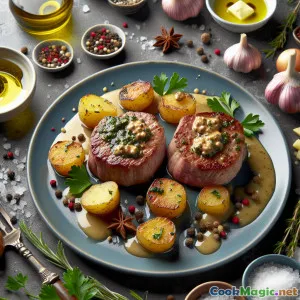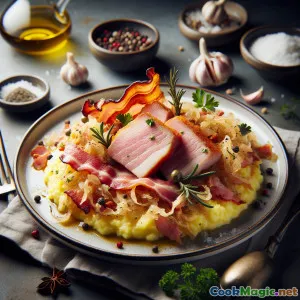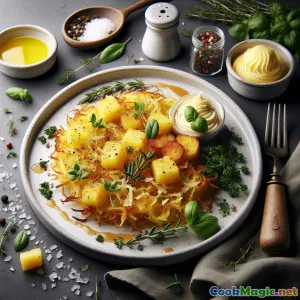
脆皮阿尔卑斯香草煎土豆饼
(Crisp Alpine Herb Rösti)
(0 评论)食材
-
1000 grams 蜡质土豆(Yukon Gold 或 Charlotte),去皮
(Waxy potatoes hold together; Russet gives extra crispness but looser texture)
-
40 grams 澄清黄油(ghee)或瑞士酥油
(Clarified fat resists burning and adds nutty flavor)
-
2 tbsp 菜籽油或葵花籽油
(Blended with butter for higher smoke point and even browning)
-
1.25 tsp 细海盐
(Season to taste; potatoes love salt)
-
0.5 tsp 现磨黑胡椒
(Balances the sweetness of browned potatoes)
-
2 tbsp 新鲜香葱,切得很细
(Classic Swiss herb brightness)
-
2 tbsp 扁叶欧芹,切碎
(Adds freshness and color)
-
1 tsp 新鲜百里香叶,切碎
(Earthy alpine note)
-
0.5 tsp 新鲜迷迭香,切得非常细
(Use sparingly; potent aroma)
-
1 clove 大蒜(剁碎)
(Lightly perfume; do not overpower the potatoes)
-
0.5 tsp 柠檬皮屑,细磨
(Lifts and brightens the herbs)
-
60 grams Gruyère AOP 粗粒刨丝奶酪
(Optional melt for the last minute)
-
1 tsp 玉米淀粉
(Helps bind if using raw, very watery potatoes)
-
4 tbsp 供上桌用的法式酸奶油
(Cool tang alongside the crisp rösti)
-
0.5 tsp 薄片收尾盐
(Sprinkle just before serving)
(Waxy potatoes hold together; Russet gives extra crispness but looser texture)
(Clarified fat resists burning and adds nutty flavor)
(Blended with butter for higher smoke point and even browning)
(Season to taste; potatoes love salt)
(Balances the sweetness of browned potatoes)
(Classic Swiss herb brightness)
(Adds freshness and color)
(Earthy alpine note)
(Use sparingly; potent aroma)
(Lightly perfume; do not overpower the potatoes)
(Lifts and brightens the herbs)
(Optional melt for the last minute)
(Helps bind if using raw, very watery potatoes)
(Cool tang alongside the crisp rösti)
(Sprinkle just before serving)
营养
- 份量: 4
- 每份大小: 1 wedge (250g)
- Calories: 420 kcal
- Carbohydrates: 0 g
- Protein: 7 g
- Fat: 18 g
- Fiber: 5 g
- Sugar: 2 g
- Sodium: 620 mg
- Cholesterol: 25 mg
- Calcium: 120 mg
- Iron: 2.2 mg
制作步骤
-
1 - Prep and grate potatoes:
Peel potatoes and grate on the large holes of a box grater or food processor disc. Pile into a clean towel and squeeze firmly to expel as much liquid as possible.
-
2 - Season the shreds:
Toss grated potatoes with salt, pepper, chives, parsley, thyme, rosemary (if using), garlic, and lemon zest. If the shreds seem very wet, sprinkle in cornstarch and mix to coat lightly.
-
3 - Heat the pan:
Place a 10–12 inch heavy cast-iron or stainless skillet over medium heat. Add clarified butter and oil. When shimmering and a test shred sizzles instantly, the pan is ready.
-
4 - Form and start the rösti:
Add potatoes, spreading evenly. Use a spatula to pat into a compact, level cake about 1.5–2 cm thick. Do not stir once formed. Reduce heat to medium-low for even browning.
-
5 - Crisp the first side:
Cook undisturbed until the edges are deeply golden and the bottom feels set when you shake the pan, 8–10 minutes. Rotate the pan occasionally to avoid hot spots.
-
6 - Flip safely:
Loosen edges with a thin spatula. Invert onto a large plate, then slide the rösti back into the pan browned-side up. If the pan looks dry, add a teaspoon of oil.
-
7 - Finish and enrich:
Cook the second side until crisp and cooked through, 6–8 minutes. In the final minute, scatter Gruyère on top if using and cover briefly to melt.
-
8 - Rest and Serve:
Slide to a board, rest 2 minutes for the crust to set. Sprinkle flaky salt. Cut into wedges and serve hot with crème fraîche, if desired.
Peel potatoes and grate on the large holes of a box grater or food processor disc. Pile into a clean towel and squeeze firmly to expel as much liquid as possible.
Toss grated potatoes with salt, pepper, chives, parsley, thyme, rosemary (if using), garlic, and lemon zest. If the shreds seem very wet, sprinkle in cornstarch and mix to coat lightly.
Place a 10–12 inch heavy cast-iron or stainless skillet over medium heat. Add clarified butter and oil. When shimmering and a test shred sizzles instantly, the pan is ready.
Add potatoes, spreading evenly. Use a spatula to pat into a compact, level cake about 1.5–2 cm thick. Do not stir once formed. Reduce heat to medium-low for even browning.
Cook undisturbed until the edges are deeply golden and the bottom feels set when you shake the pan, 8–10 minutes. Rotate the pan occasionally to avoid hot spots.
Loosen edges with a thin spatula. Invert onto a large plate, then slide the rösti back into the pan browned-side up. If the pan looks dry, add a teaspoon of oil.
Cook the second side until crisp and cooked through, 6–8 minutes. In the final minute, scatter Gruyère on top if using and cover briefly to melt.
Slide to a board, rest 2 minutes for the crust to set. Sprinkle flaky salt. Cut into wedges and serve hot with crème fraîche, if desired.
关于 脆皮阿尔卑斯香草煎土豆饼 :的更多信息
Overview Bernese Mountain Herb Rösti celebrates the Swiss love affair with potatoes, crisped to a lacy, golden armor that protects a tender interior. The aromatic lift of chives, parsley, thyme, and a whisper of rosemary channels the alpine meadows of the Bernese Oberland. This version respects tradition while leaning into freshness: the herbs perfume without masking the potato’s gentle sweetness, and clarified butter adds the nutty richness you expect from a chalet breakfast or a rustic tavern supper.
Why it works
- Water management: Squeezing moisture from freshly grated potatoes helps the surface starch gel and brown instead of steam. A drier shred equals better crust.
- Fat choice: Clarified butter boosts nutty flavor and browning while oil raises the smoke point, keeping the butter from scorching during the long, steady sizzle.
- Thickness discipline: At 1.5–2 cm, the cake cooks through by the time both sides are deeply golden, giving a creamy interior without raw crunch.
- Minimal movement: Press to compact, then leave it alone. Patience builds the signature crust.
Key techniques and tips
- Grate and squeeze: Use a clean towel or cheesecloth to wring out liquid. If you have time, let shreds sit 2–3 minutes, then squeeze again; more moisture escapes on the second pass.
- The flip: Commit to it. Loosen thoroughly, then invert onto a plate and slide back into the pan. If you fear breaking, make two smaller röstis for easier handling.
- Heat management: Begin with medium to start the sizzle and quickly build crust, then reduce to medium-low so the interior can cook through without burning.
- Optional binding: A teaspoon of cornstarch helps if your potatoes are very fresh and high in moisture, especially when you skip the classic Swiss method of parboiling and chilling potatoes the day before.
Ingredient notes
- Potatoes: Swiss cooks often use firm, waxy varieties. They hold together, slice neatly, and produce a custardy interior. Russets offer maximum crispness and a looser, more lacy structure; both are delicious, just different.
- Herbs: Chives and parsley are foundational; thyme echoes alpine shrubs; rosemary should be used lightly. A hint of lemon zest brightens and keeps the flavors from feeling heavy.
- Fat: Clarified butter (butterschmalz) is traditional in the Alps and ideal for high-heat frying. If unavailable, combine 1 tablespoon unsalted butter with 1 tablespoon neutral oil per 8–9 inch of pan surface.
- Cheese: Gruyère is optional and should be added at the end, just to kiss the top. Rösti is not a cheese pancake; restraint keeps it authentic in spirit.
Serving suggestions
- Classic: With fried or poached eggs and a tangle of dressed greens.
- Mountain supper: Top with smoked trout, horseradish crème, and dill.
- Alpine vegetarian: Pair with sautéed wild mushrooms and a squeeze of lemon.
- Festive: Cut into bite-size wedges and serve as a canapé with herbed sour cream.
History and cultural significance Rösti began as a farmer’s breakfast in the Bern canton, fueling long days in the fields. Over time it became a national symbol of Swiss simplicity and regional pride—the so-called Röstigraben even humorously marks the cultural divide between German- and French-speaking Switzerland. While purists argue for potatoes, fat, and salt only, seasonal herbs are well within the country kitchen tradition, reflecting gardens that flourish even at altitude during the brief alpine summer. This herb-lifted version nods to that heritage while suiting contemporary palates that crave brightness alongside comfort.
Variations
- Bernese bacon: Render diced bacon first, then cook the rösti in the drippings with a touch of butter. Omit additional salt accordingly.
- Root rainbow: Add a quarter portion of grated celeriac or carrot for sweetness and complexity.
- Onion rösti: Stir in finely shaved onion, lightly sweated in butter until translucent; this echoes the Zürcher style.
- Mini rösti: Form smaller individual cakes for easier flipping and appetizer service.
Troubleshooting
- Pale, soft crust: Increase heat slightly and give it time; too much moisture or premature flipping can sabotage browning.
- Burnt spots: Your pan has hot zones; rotate and adjust the flame. A little extra oil around the rim can help even out color.
- Falling apart on flip: Compress more firmly at the start, cook longer on the first side, or make two smaller cakes.
Make-ahead and shortcuts
- Day-before method: Parboil whole potatoes 8–10 minutes, chill uncovered overnight, then peel and grate. The chilled starch makes röstis that hold beautifully and brown evenly.
- Same-day boost: After squeezing, microwave the shreds for 2–3 minutes to pre-gelatinize surface starch, then cool briefly before frying.
Sustainability notes Choose locally grown potatoes and herbs when possible. Clarified butter can be made from surplus butter, extends shelf life, and reduces waste. Cast-iron pans, seasoned well, are lifetime tools that deliver consistent results without disposables.
Personal thoughts There is a rare joy in the quiet sizzle of rösti: the way the kitchen fills with the scent of butter and herbs, the patient wait as edges brown, the decisive flip, and finally the first fork crack through the crust. It is humble food that feels celebratory, especially in company. Share it at the table, pass the crème fraîche, and listen for that crisp whisper as the knife slides through—an alpine applause in your own home.

